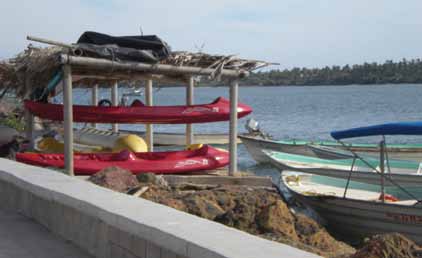Contents | 3 | 4 | 5 | 6 | 7 | 8 | 9 | 10 | 11 | 12 En español
Financially troubled fisherman
transforms family business

When fishing stopped being profitable because of the high cost of supplies (such as gasoline, fishing gear and maintenance) and the low profits generated. Méndez trained to become
Photo: Griselda Franco
a tour boat operator, commenting: “to be involved in tourism, you have to prepare yourself.” He is now certified by the Secretary of Tourism as an interpretive tour guide. To become a guide, he also took classes in first aid, management of protected areas and tourist services.
The National Commission of Protected Natural Areas (Conanp) helped him to buy three kayaks that he rents out, because the cooperative is interested in helping to protect the environment through low-impact activities.
In his guided boat trips, Méndez uses low impact, environmentally friendly motors and recommends that everyone, including fishermen in Teacapán, buy these because they reduce pollution.
Besides giving thanks to this grandfather, one of the first guides in Teacapán, he is also grateful to Dr. Ernesto Rivera Valdés for promoting tourism since he helped Méndez to form his own cooperative, Paseos Turísticos Isla de Pájaros.
 This microbusiness carries with it many ecological and environmental benefits that help to preserve the wide variety of ecosystems, mangroves, birds and fish that can be found in the estuary.
This microbusiness carries with it many ecological and environmental benefits that help to preserve the wide variety of ecosystems, mangroves, birds and fish that can be found in the estuary.
For the future, he is contemplating the construction of guest rooms. His project favors the creation of productive networks, the sale of local goods, the creation of new jobs and the improvement of Teacapán’s image, holding it up as an example of a sustainable development project.
CETMar (Center for Technological Marine Studies) No. 23
Local pride in Teacapán results
in healthy fun for tourists
This port town of fishermen bordering Nayarit on the south is suffering from the decline in the global fisheries. However, being located in an ecological mangrove preserve provides an alternative economic opportunity in ecotourism for fisherman Víctor Manuel Méndez Denis.
Forty-two year old Méndez Denis is from Teacapán, Sinaloa. He recently started a ecotourism cooperative out of economic necessity since he could no longer count on making enough money from fishing to support his family.
The idea of the small cooperative offering tourist services wasn’t just an impulsive one. Méndez speaks of how his starting the cooperative makes him proud since it reminds him of his grandfather Sixto Denis Aguirre who was also a tour guide. Méndez already has 15 years of experience as a guide in the reserve.
Currently he makes trips to Isla de Pájaros, the mangroves and the archeological zone where there are shell middens, as well as other places that tourists might want to visit.
Méndez also rents kayaks, “bananas”, jet skis and other water sports equipment. A year ago, he started a small restaurant facing the seafront, rehabilitating a trailer park abandoned about 60 years ago to do so.

He says that he wouldn’t leave Teacapán for anything in the world because it’s a paradise where his friends and family live. He adds that he is proud of his birthplace because tourists tell him they would love to live there and have everything that he does.
“They should come to Teacapán,” he challenges. “They won’t be sorry.”
*CETMar (Center for Marine Technology Studies) No. 23